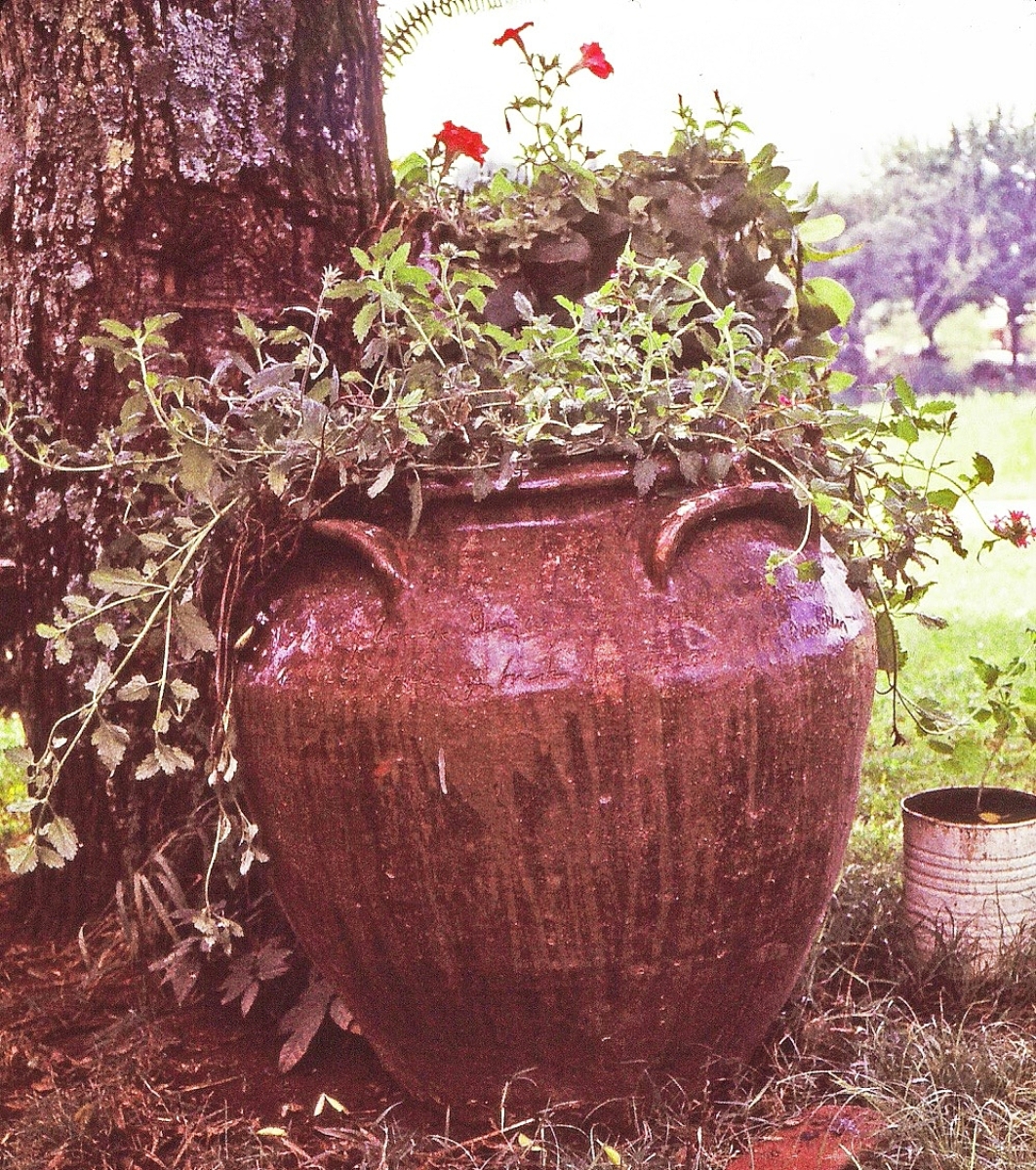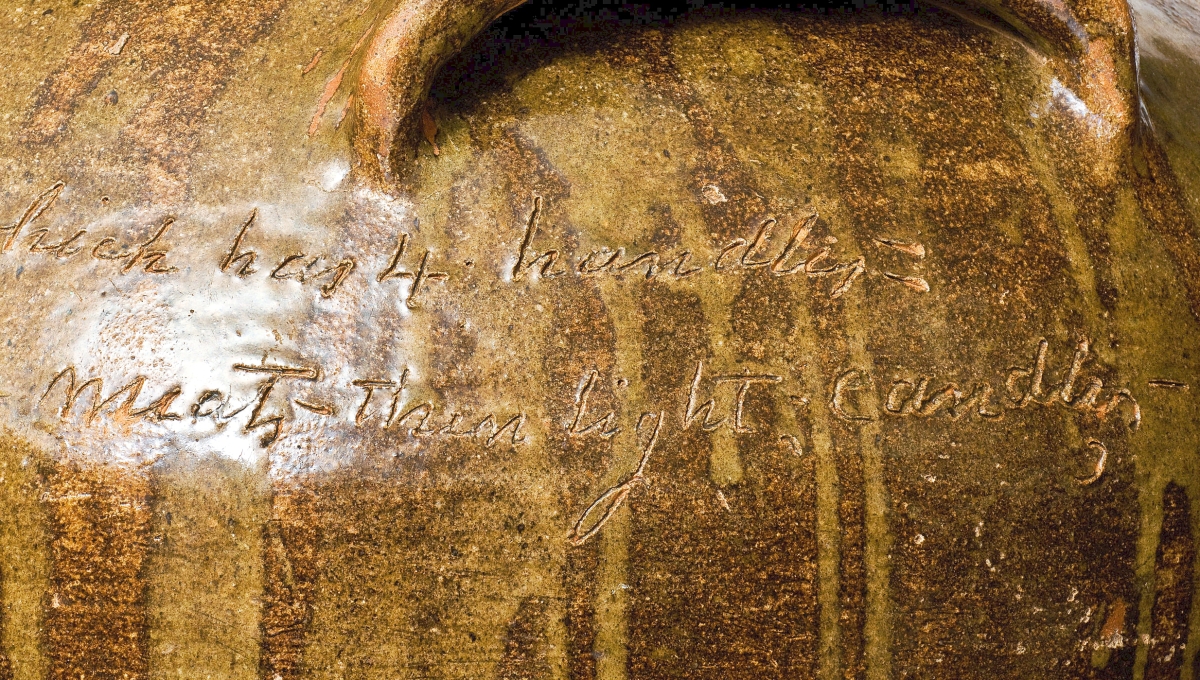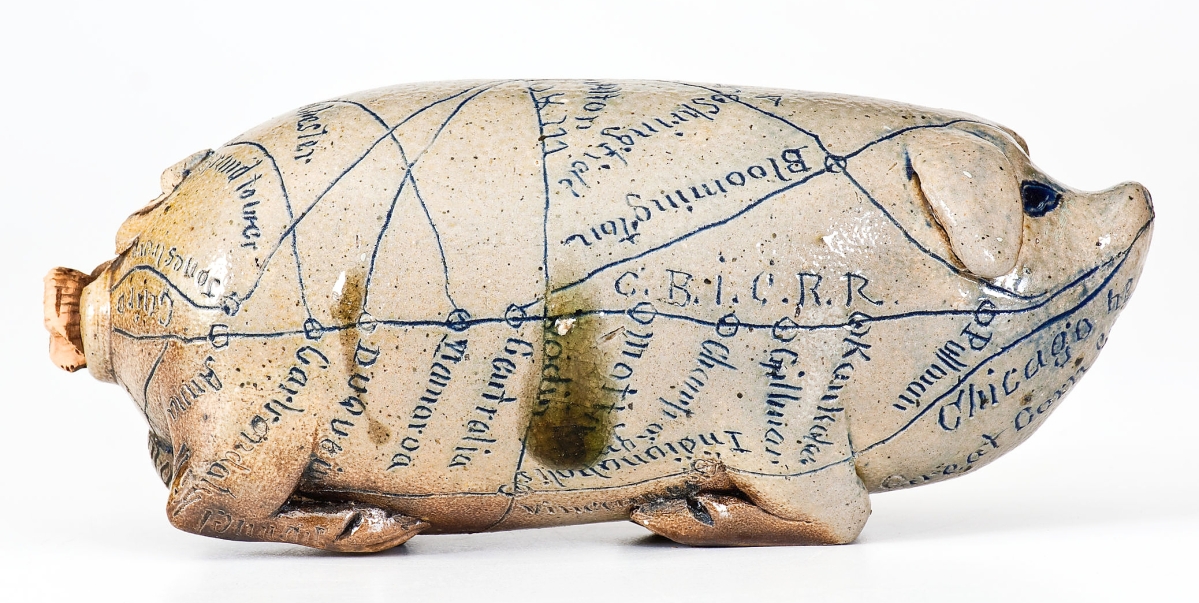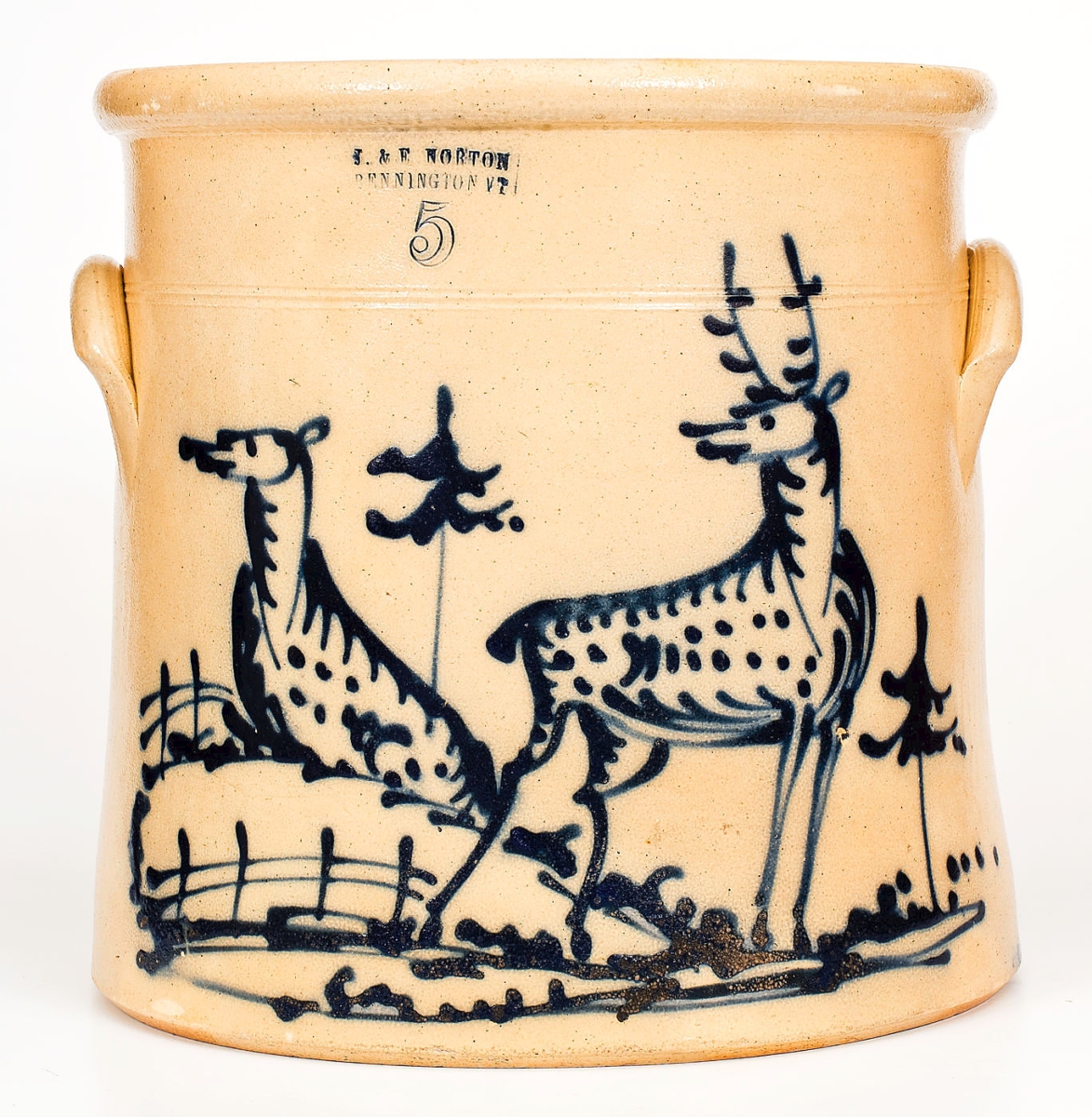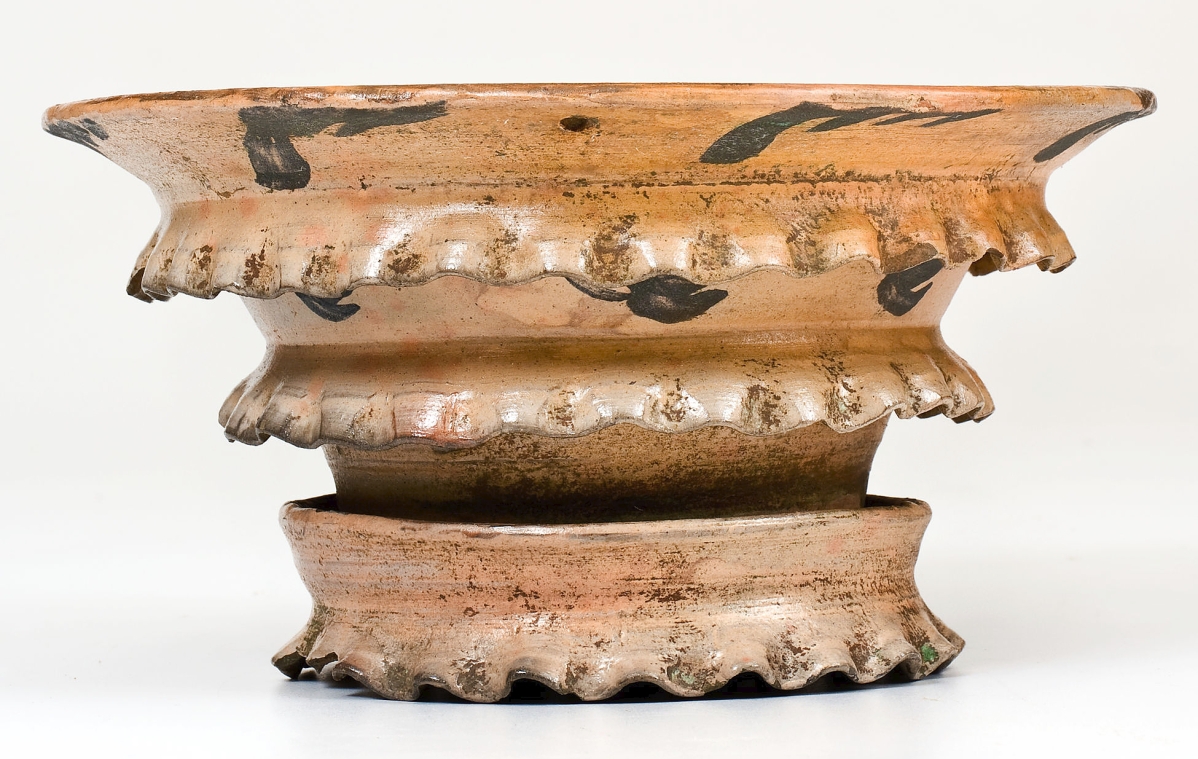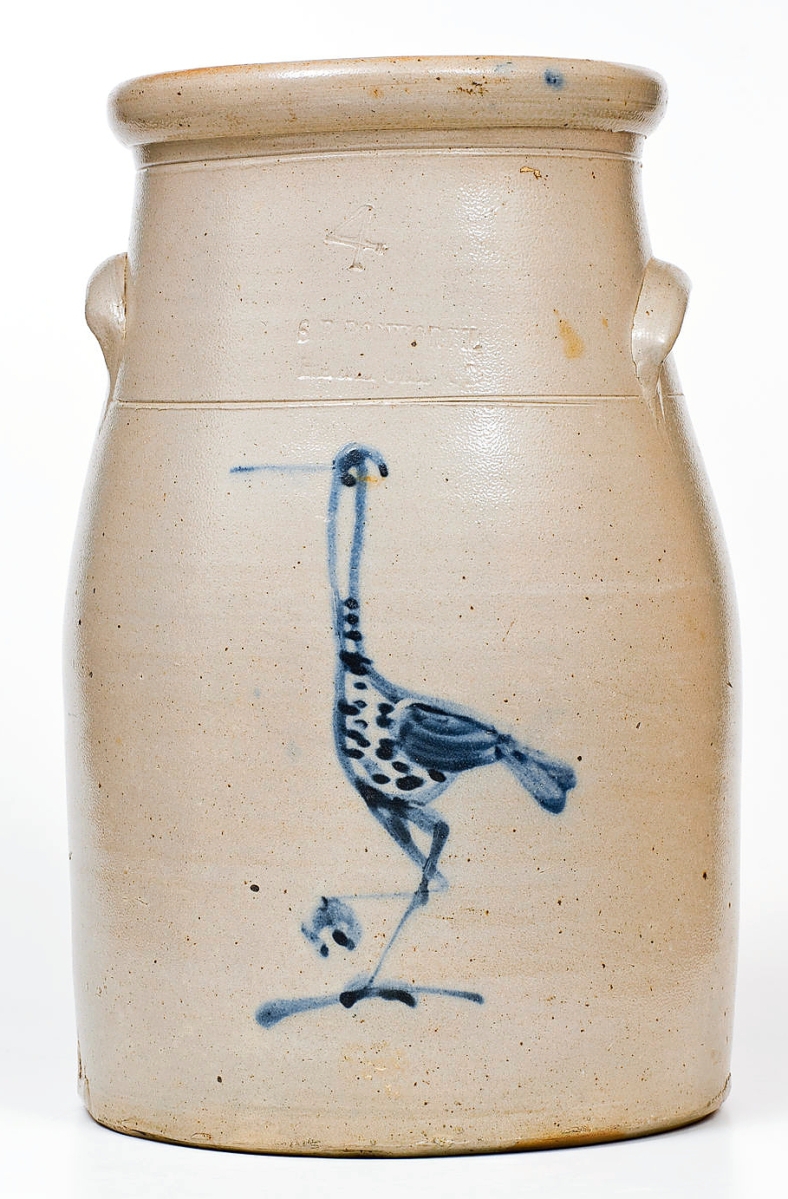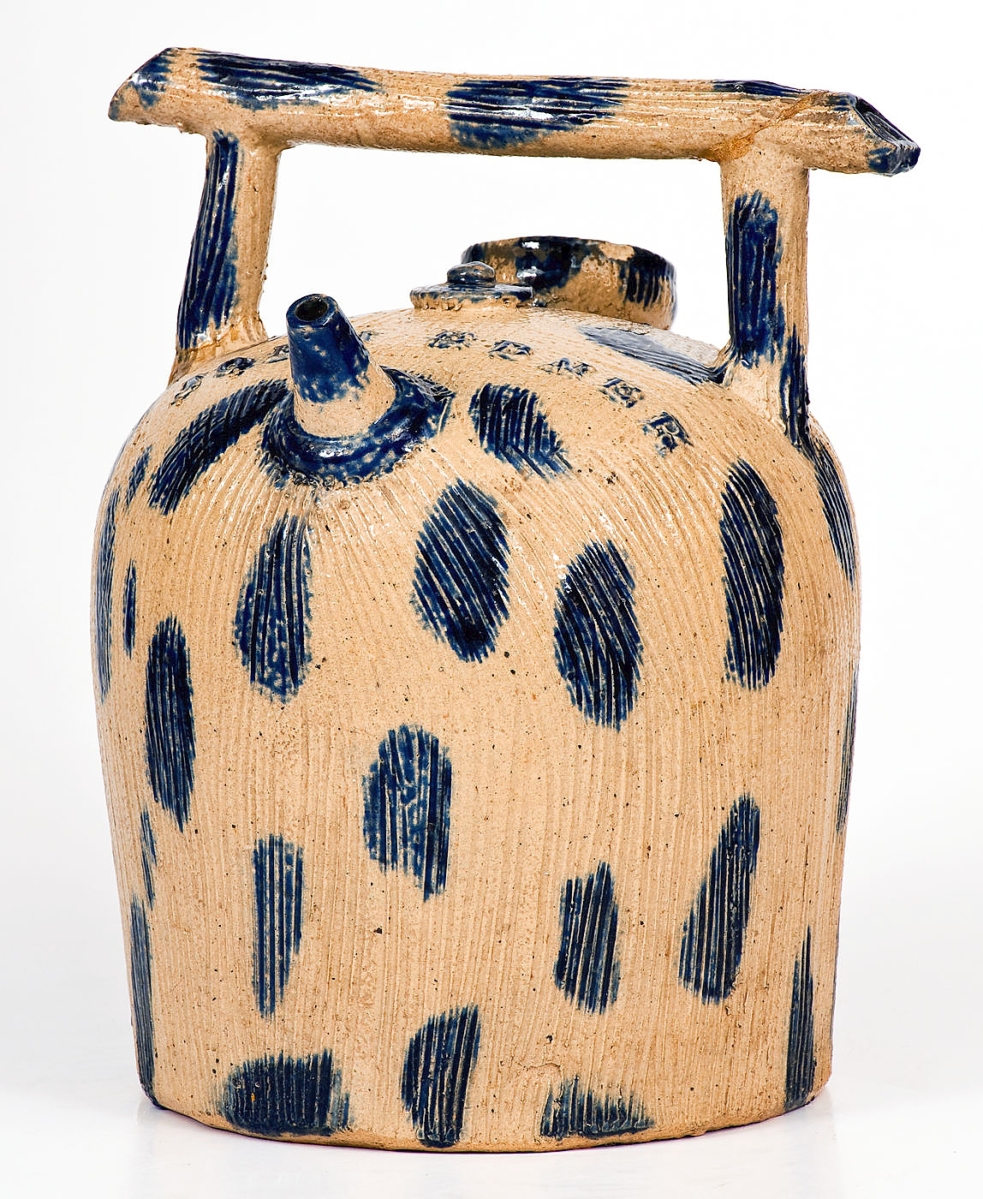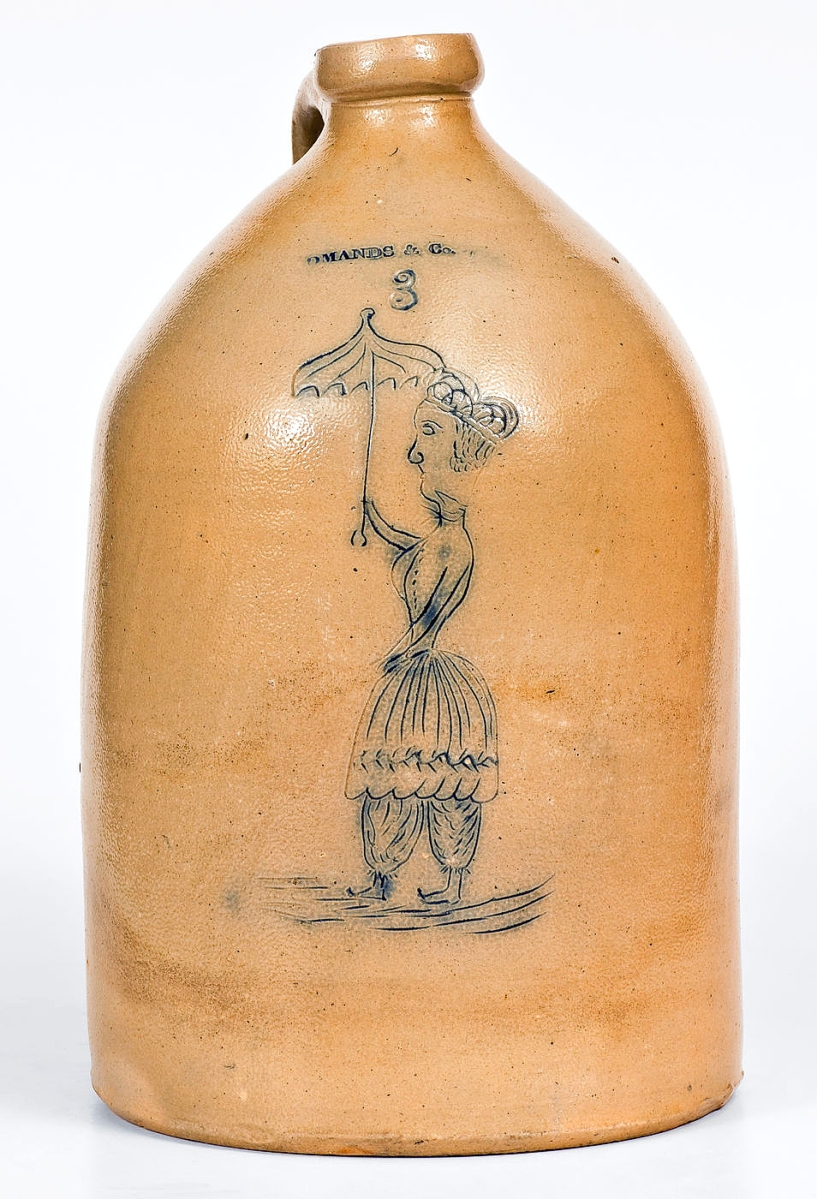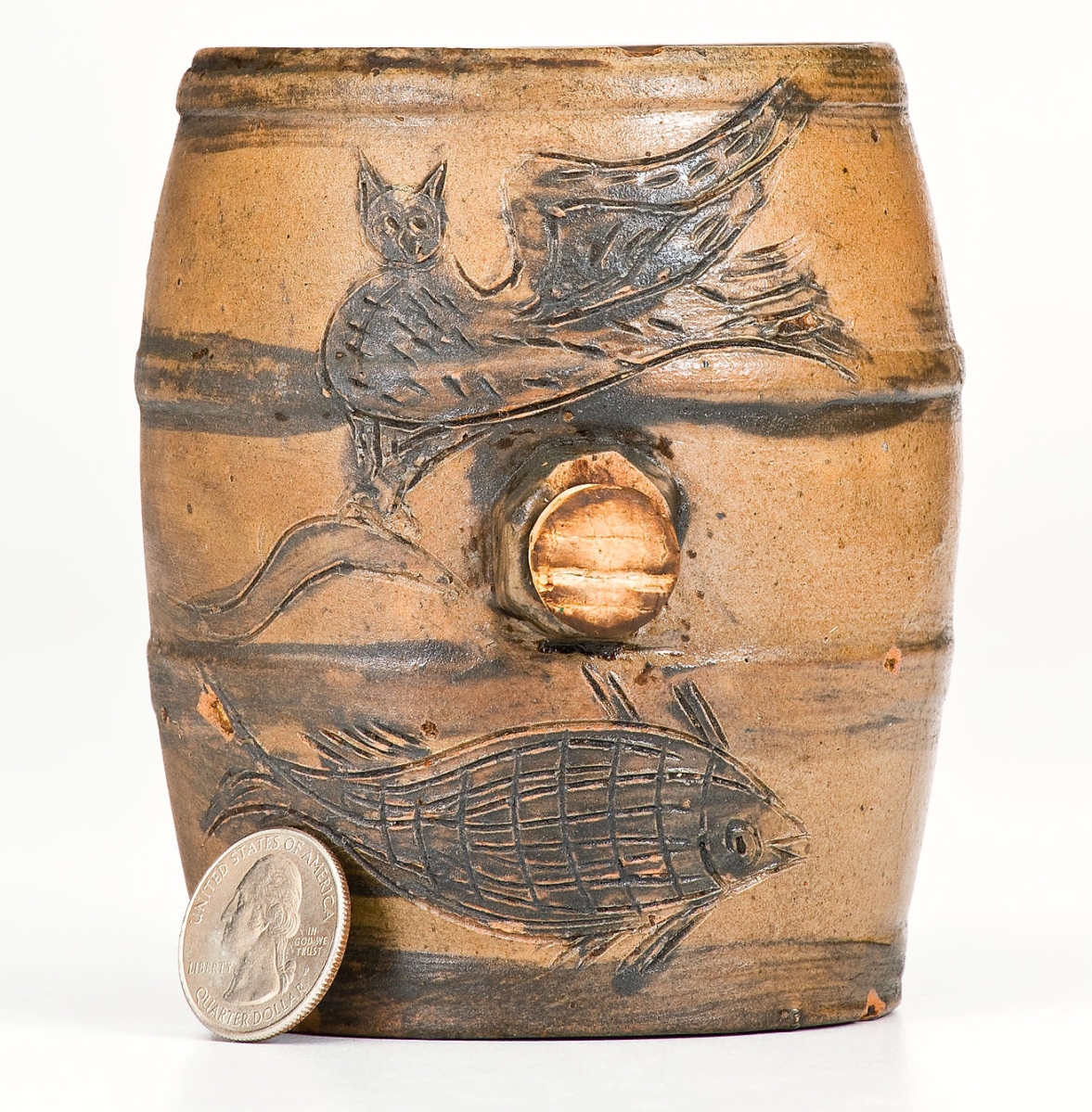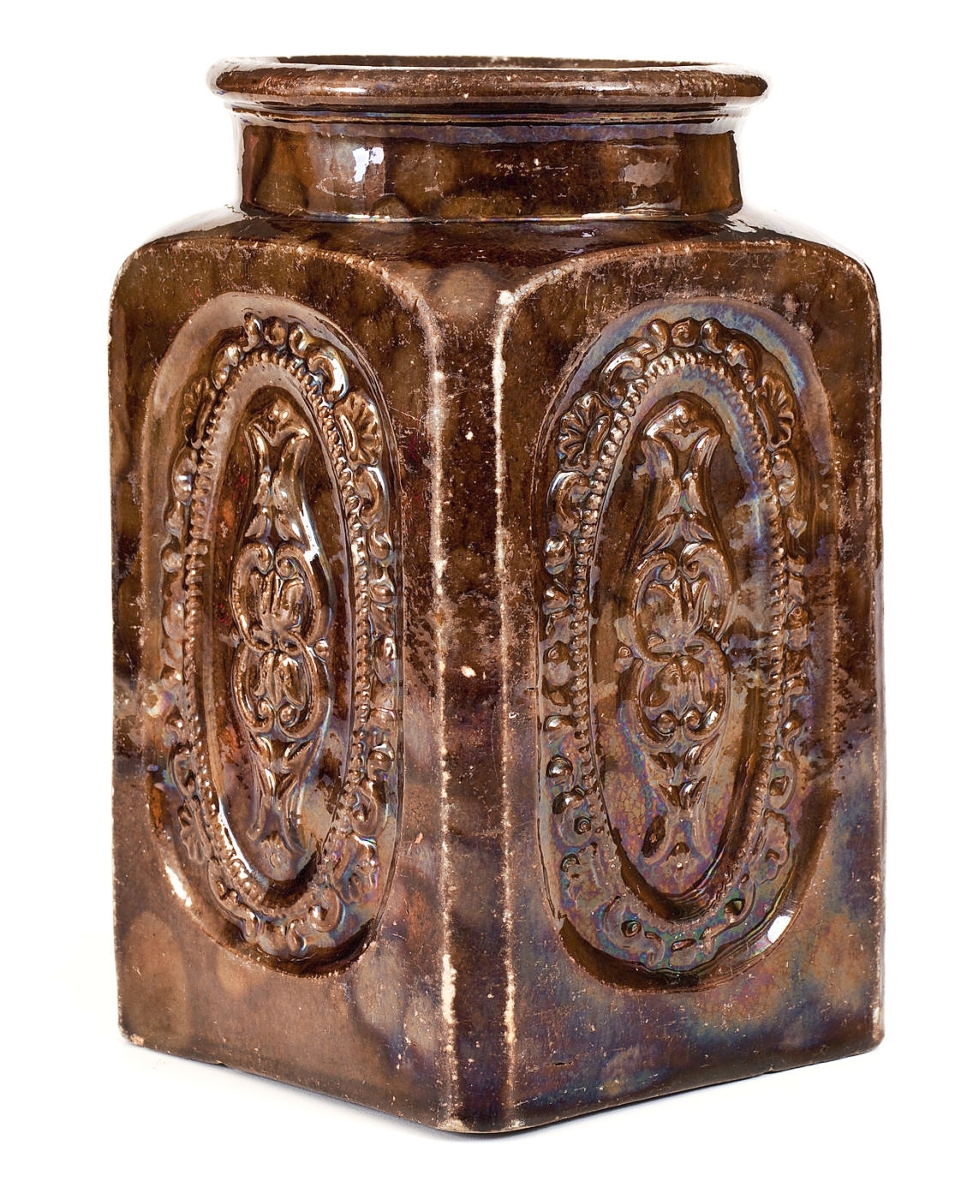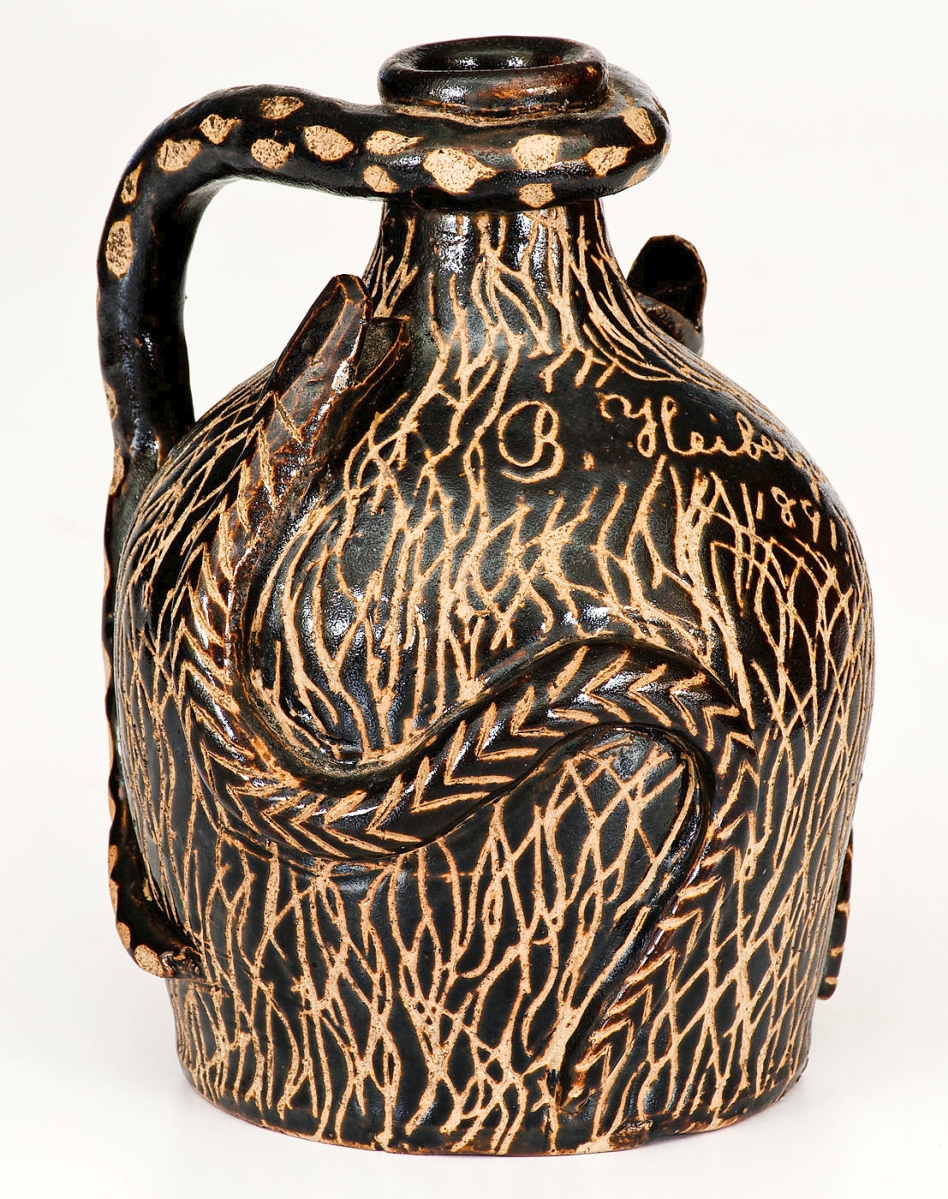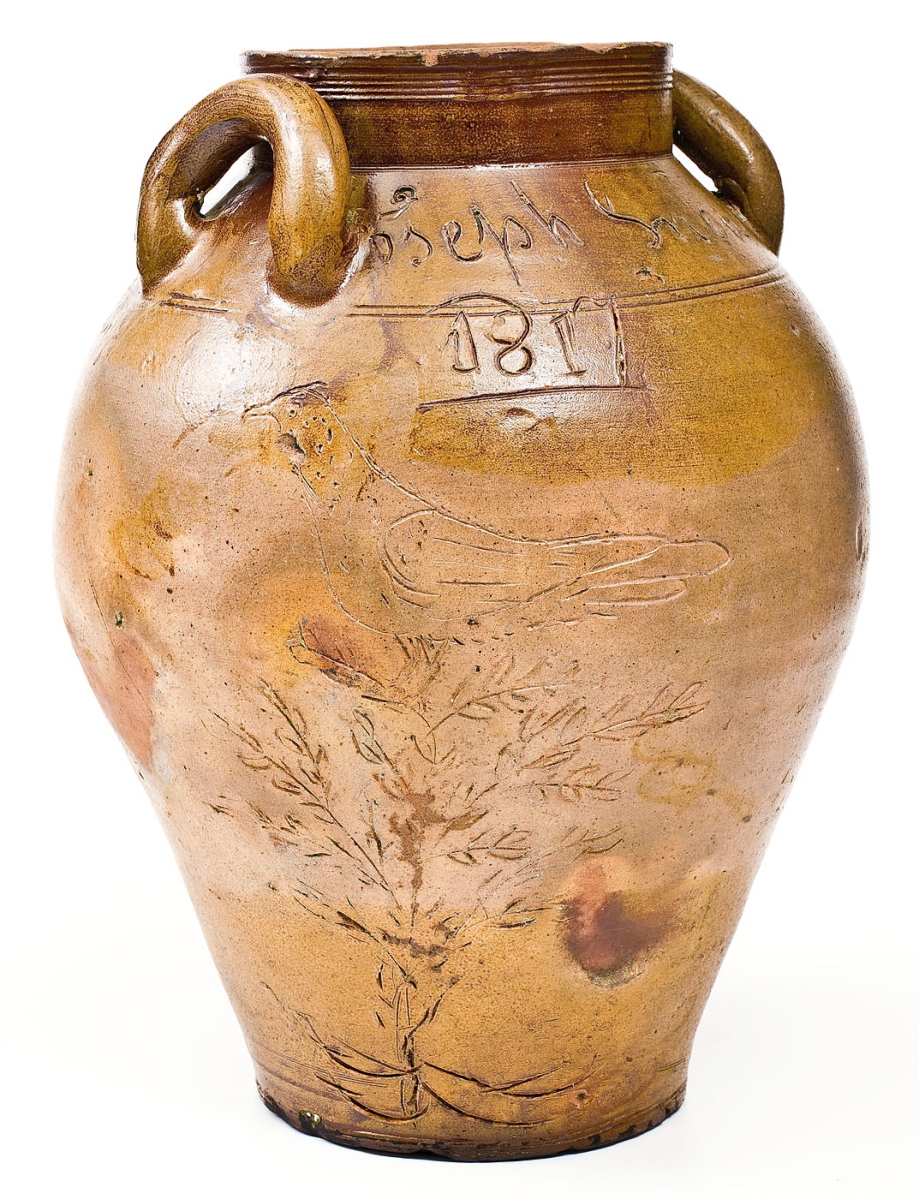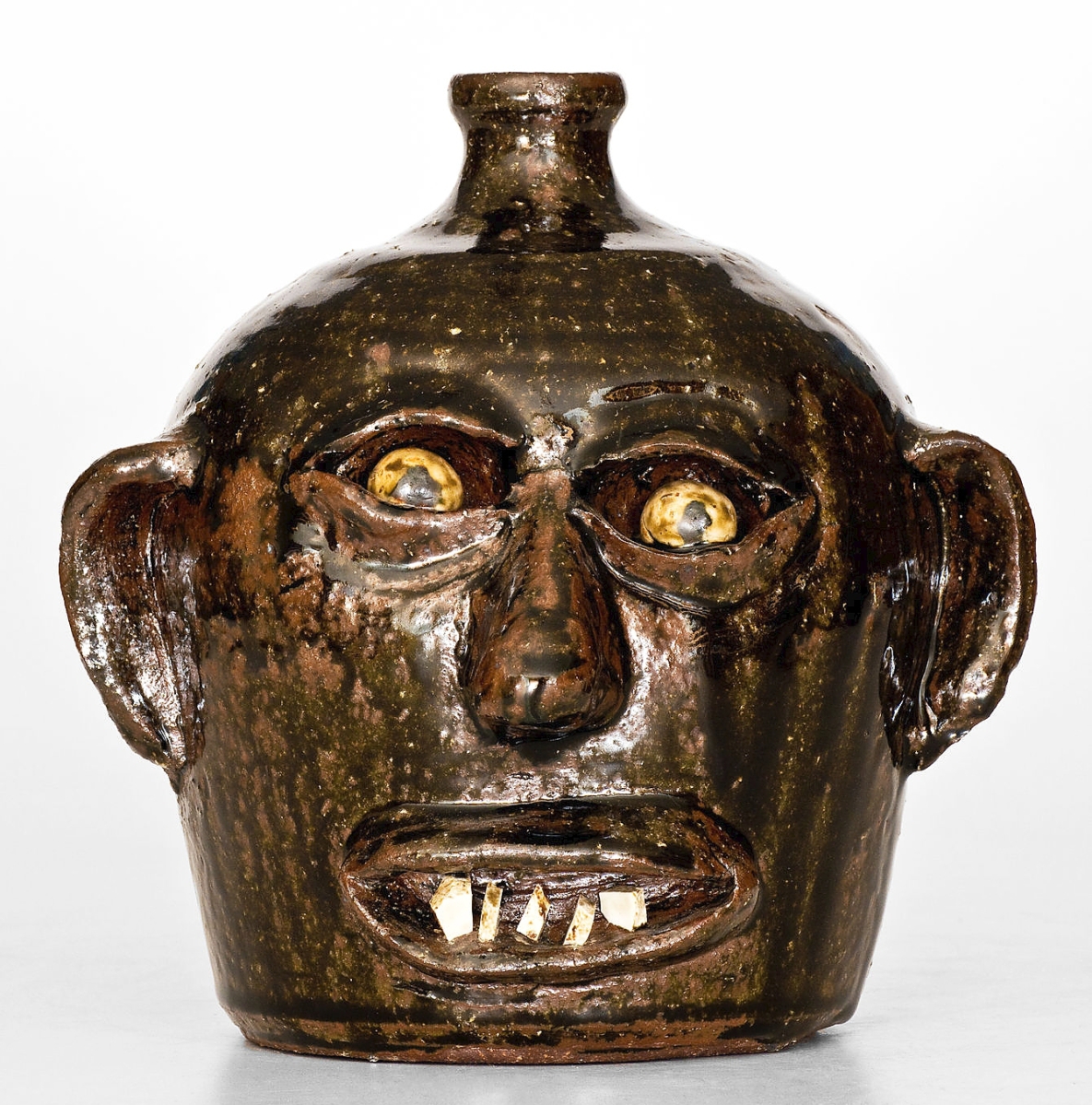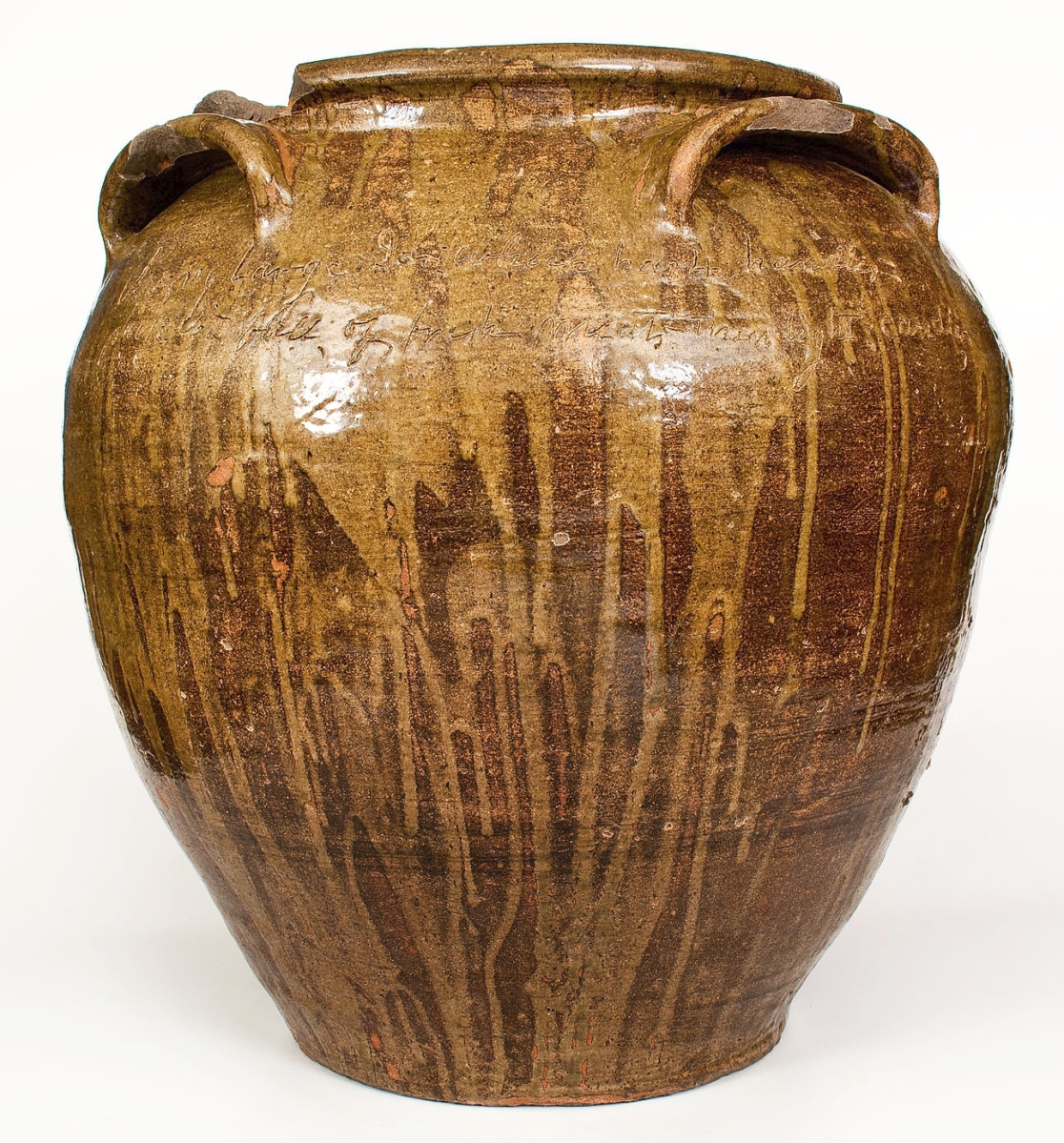
As of today, the highest grossing work of American pottery is a 25-gallon jar by enslaved African American potter Dave Drake. The jar sold for $1,560,000 in Crocker Farm’s sale, besting an $800,000 record-holding result on a John Bartlam teapot in 2018. It features the poem “A very Large Jar which has 4 handles / pack it full of fresh meats- then light candles” and is signed and dated April 12, 1858. The work was discovered by folk art scholar John Burrison, who consigned it. An as-yet unnamed institution purchased it.
Review by Greg Smith, Photos Courtesy Crocker Farm
SPARKS, MD. – An important benchmark in Americana was set at Crocker Farm’s Summer Auction as the enslaved African American potter Dave Drake rose to become the highest grossing potter in American history. His monumental four-handled poem jar sold for $1,560,000 to Crystal Bridges Museum of American Art in Arkansas.
The sale closed on the morning of August 7 to a gross total of $3,147,450 million, an auction house record.
The work was critically regarded as a masterpiece by Drake, who created it in a 25-gallon monumental size measuring 24½ inches high.
Auction house partner Mark Zipp said there are about 35 poem jars known by Drake, produced amid a prolific career in utilitarian wares while enslaved in the Edgefield-area potteries between 1820 and 1865. Drake’s works with poems, couplets or other writings are considered his most important. The poems represent “An Act of Resistance,” as the New York Times recently put it in a June feature – they stand as a testament to a man who practiced his freedom to read and write, going so far as to publicly set it in stone, during a time when it was illegal for him to do so.
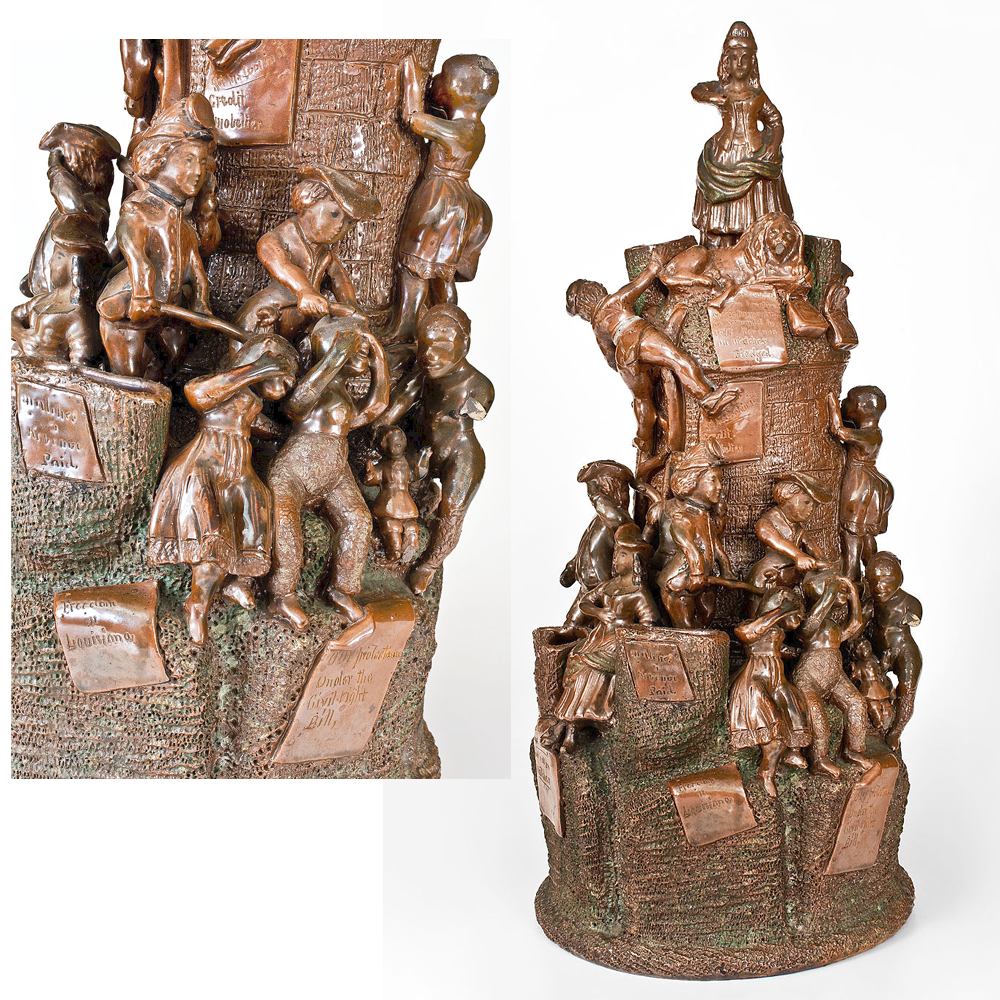
The Liberty Monument set a record for Anna Pottery when it sold for $600,000 to Winterthur. It features images of both the Colfax Massacre and the shame of Schuyler Colfax, the vice president implicated in fraud under the presidency of Ulysses S Grant. “It’s a double meaning on the word ‘Colfax,'” Mark Zipp said. “The Colfax that have and the Colfax that have not— the one that had it and blew it and the others who never did.” Winterthur plans to use the work to inspire challenging conversations about our nation’s history, calling it a “transformational acquisition.”
A spokesperson for Crystal Bridges said, “This rare and important acquisition reveals how many stories objects like this can help museums show and tell: we can delve into materials and histories of craft, American history, enslavement, the meat industry, relationships between labor and art, and the artistry of David Drake. And we can invite additional perspectives.”
This is the first work by Drake in the collection of Crystal Bridges and the museum noted its purchase was made possible by general acquisition funds.
When queried on the intersection between the art and market, more specifically with how an enslaved African American is now the highest grossing potter in American history, the museum replied, “The significance is how exceptional and rare this object is and the value that holds for audiences. This is an opportunity to make David Drake’s art and contributions to American history and culture more widely known and provide access to his work in a free, public museum.”
It had been a while since a good poem jar had come to market, Zipp noted. Most of the works that had set artist auction records lately for Drake – four records in 15 months – were signed, but without a good couplet.
“We were in relatively uncharted territory in this marketplace,” Zipp said. “There have been Dave jars, sure. But in the last few years, they’ve gone up in value dramatically. At the same time that the market is rising, there has been a huge gap in time since a really great poem has come up for sale.”
Dave Drake’s jars have always held a sense of fame, Zipp explained. A Nineteenth Century newspaper article speaks about Dave Drake in a reverential tone, noting his magic touch during his 35-year career. In the early Twentieth Century, more accounts emerge from those who remembered him fondly for his skill. From these accounts, we learn Dave Drake may have done this all on one leg, having lost the other in an unknown event. In 1919, a letter with the Charleston Museum indicates researchers were attempting to find out who this potter signed Dave was. In 1978, John Michael Vlach includes Dave Drake in his seminal work The Afro-American Tradition in Decorative Arts. Fifteen years later in 1993, Baldwin releases perhaps the best and most thorough treatise on Edgefield pottery, Great and Noble Jar, its title taken from one of Drake’s poems.
In the 1990s, the market for Drake’s poem jars hovered from $20,000 to $50,000. The Harmer Rooke Galleries reportedly sold examples from the Georgeanna Greer collection, including a number of poem jars, around the $30,000 mark or less.
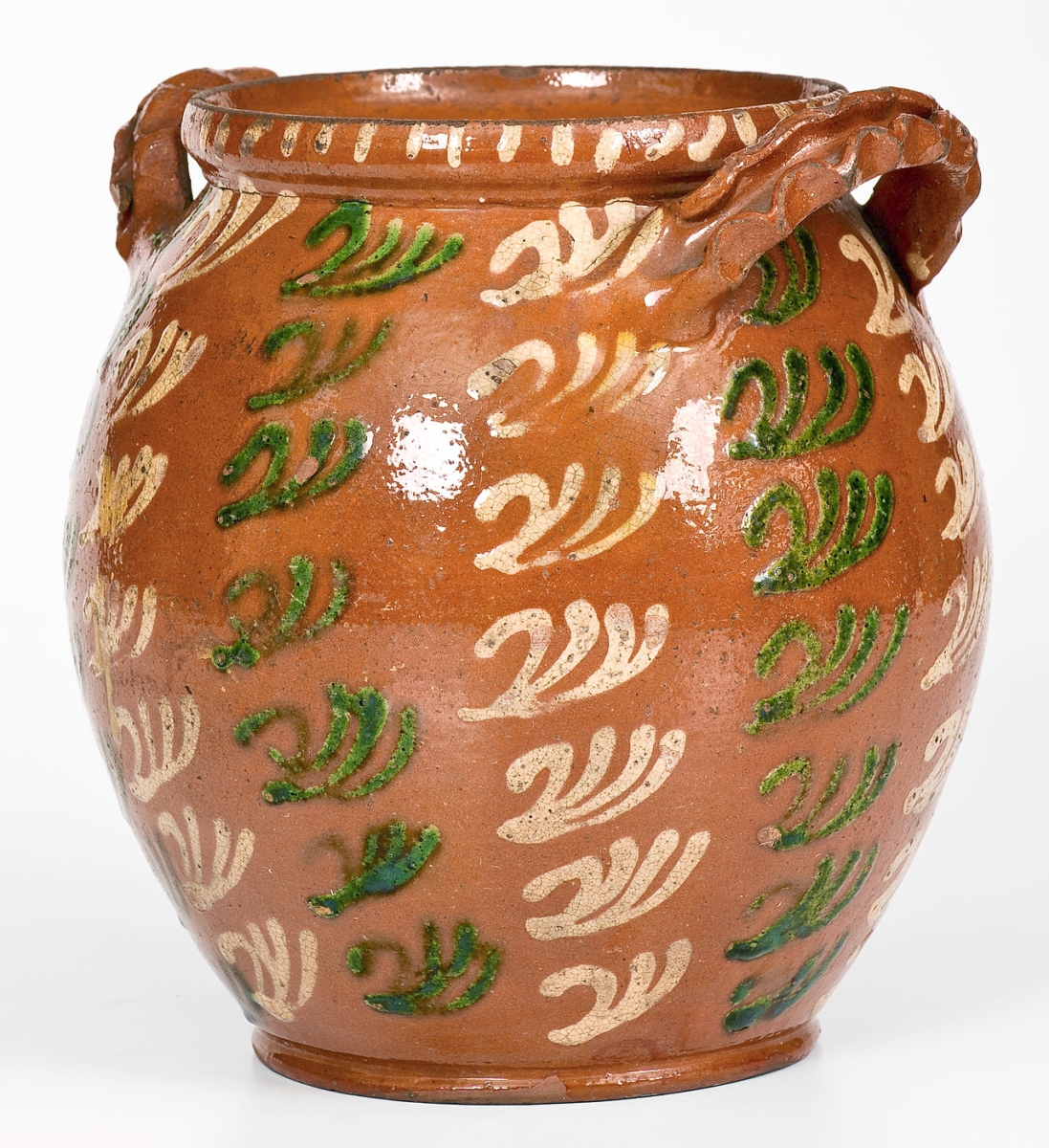
A redware jar that related to one in the collection of the Philadelphia Museum of Art sold for $132,000 above a $12,000 high estimate. The jar was attributed to Christian Klinker of Nockamixon Township, Bucks County, Penn. Circa 1773-98, Mark Zipp said it’s the distinct handles that relate to Klinker’s work. “The handles are well-done, the crimping is bizarre and very distinctive. They’re unmistakable,” he said. The work came from the collection of Lewis Fenley “Dusty” Parker, who had purchased it at Christie’s in 1999 from the John Gordon collection.
It’s in this same period that scholarship on Southern pottery starts picking up and among those pushing it forward is John Burrison.
“He’s one of the formative figures in putting Southern pottery on the map,” Zipp said. “Many of the attributions for Southern pottery have stemmed from his research. His passion for it has helped found and drive the market for Southern pottery.”
After learning about Dave in the 1970s, Burrison found himself driving along the roads of Georgia when he saw a large alkaline-glazed pot out of the corner of his eye. It sat on a farm at the base of a tree with plants creeping down its sides. Brushing them away revealed a four-handled pot with the poem “A very Large Jar which has 4 handles / pack it full of fresh meats- then light candles,” with Dave’s signature and the date of April 12, 1858. After explaining the artist’s legacy to the owner, that person held onto it for another three years before giving Burrison a call. He was able to purchase it and in 1981, he lent it to the Atlanta History Center Folk Life Gallery in Atlanta, a gallery he helped found.
The work’s publication history began in 1978 when Burrison discussed it in an issue of Southern Folklore Quarterly and Vlach included it in his title the same year. Burrison would write about it in his 2000 book, Shaping Traditions: Folk Arts in a Changing South, and again in his 2008 book, Brothers in Clay: The Story of Georgia Folk Pottery. It was included in ten other scholarly articles or publications.
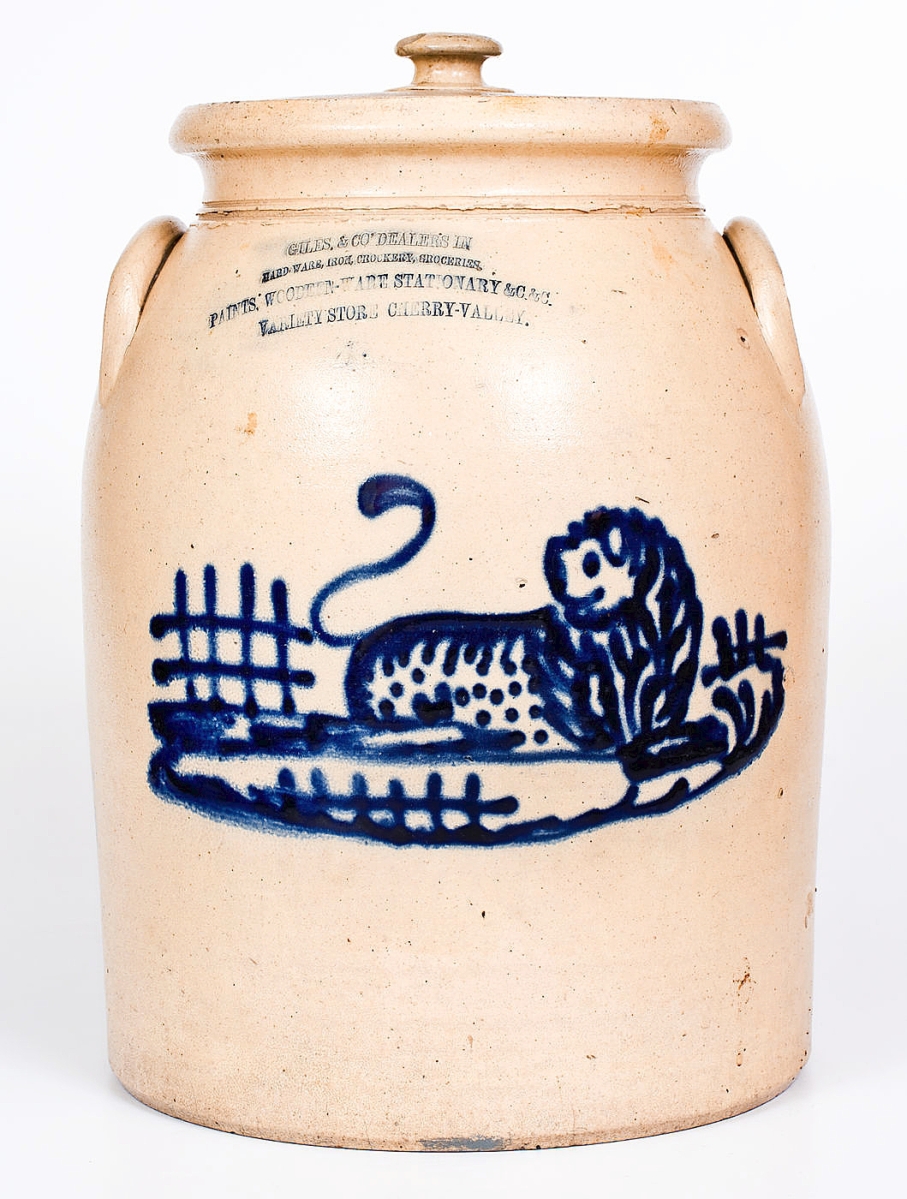
Selling for $42,500 was the fourth highest lot in the sale, a four-gallon lidded stoneware jar attributed to J&E Norton. With an image of a reclining lion, the advertising jar was made for Giles & Co, a dealer of hardware, iron, crockery, groceries, paints, woodenware, stationary and more. The general store was located in Cherry Valley, N.Y.
Meanwhile, Drake’s inspirational and tragic story propelled his market upward. That he was an enslaved African American artist was integral to the value of the work and infused within its being. His strong spirit and free will, emblazoned by the letters written across his pots, rang out louder and louder with each passing year and new discovery.
“Dave isn’t a one trick pony,” Zipp said. “His work speaks for itself. When you see it, it commands your attention. His works are jaw-droppingly beautiful and they have a level of importance that a lot of other potters never achieved.”
South Carolina auction house Charlton Hall sold the “Whats better than kissing (or) wishing while we both are at fishing” poem jar in 2004 for a $140,000 hammer. In 2005, Sotheby’s sold a jar with the word “concatination” to the rim for $60,000. A signed example with the word “Catination” brought $369,000 at Brunk in 2020. Those related works were produced by the potter 22 months apart. Other monumental Dave jars that are signed but without poems are regularly seen, but they lack the flair of the couplet.
Burrison’s meat jar was dated to within a three-week period of other known poem jars, including one at the Metropolitan Museum of Art. Drake’s poem jars are held in leading and regional institutions, including the collections of the Museum of Fine Arts, Boston, the Philadelphia Museum of Art, Charleston Museum, the Greenville County Museum of Art, the High Museum of Art, the Virginia Museum of Fine Arts, the Smithsonian, the South Carolina State Museum and the Atlanta History Center.
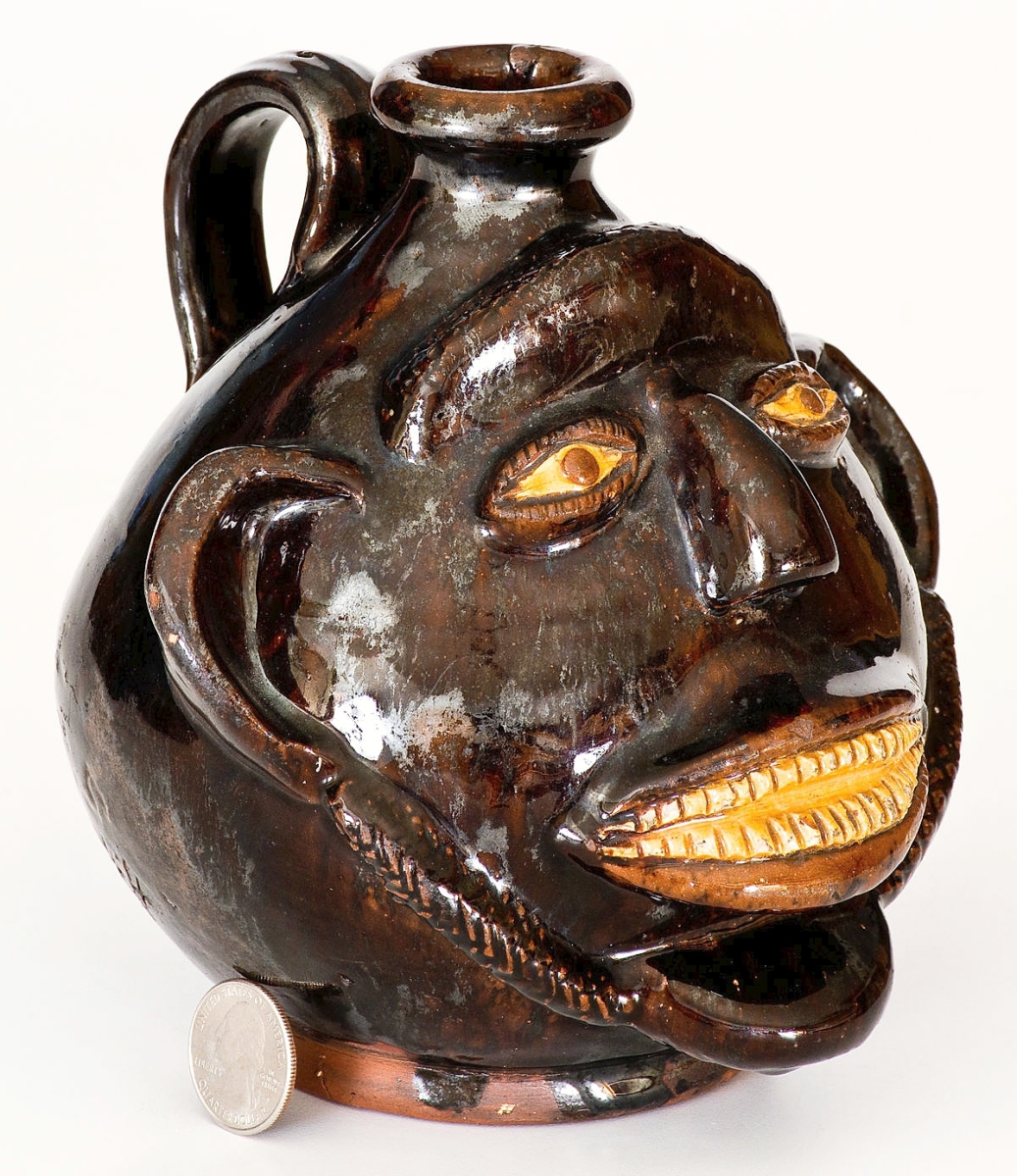
A group of these face jugs are known and Mark Zipp said this was among the best from that group. They are believed to have been made in New Jersey, found in Morristown and relating to jugs from the Thorn Pottery in Crosswicks, N.J. This example sold for $27,600.
It came to sale at the right time as museums are looking into their collections and noting a dearth of works by Black artists and artisans, particularly historical ones. And make no mistake, with four museums duking it out well into the six-figures on this example, it is without doubt that museums are pushing Drake’s market upwards.
“His writing is an almost unique aspect in American pottery,” Zipp said. “There are a few other things out there that have poems, but he’s the only potter that I’m aware of, other than sgraffito potters, that inscribed messages on a frequent level.
“It’s big for African American art. It’s a big win for utilitarian art – this idea that you have useful objects that are appreciated on the same level as fine art… at the same level as artists who went to the academies with exhibitions and training. Then you have an enslaved craftsman making these things at a very high artistic level. This is a watershed moment for his work. There aren’t many pieces of Americana outside of paintings that have brought $1 million.”
Zipp, who along with father, mother, and two brothers all run the auction house together, related the family’s joy in owning the top American pottery record.
“It’s exciting to see where it’s taking American stoneware and Dave’s work,” he said. “Dave has been studied seriously for the past few decades and you have to give some credit to the late, great Arthur Goldberg, I wish he was here today to see this number being hit. It speaks to Dave’s legacy. Arthur always wanted stoneware to be called ceramic art. It wasn’t folk art, it was art. He wanted the two to be conflated. If you look at this price, it’s a work of art in the most general sense possible.”
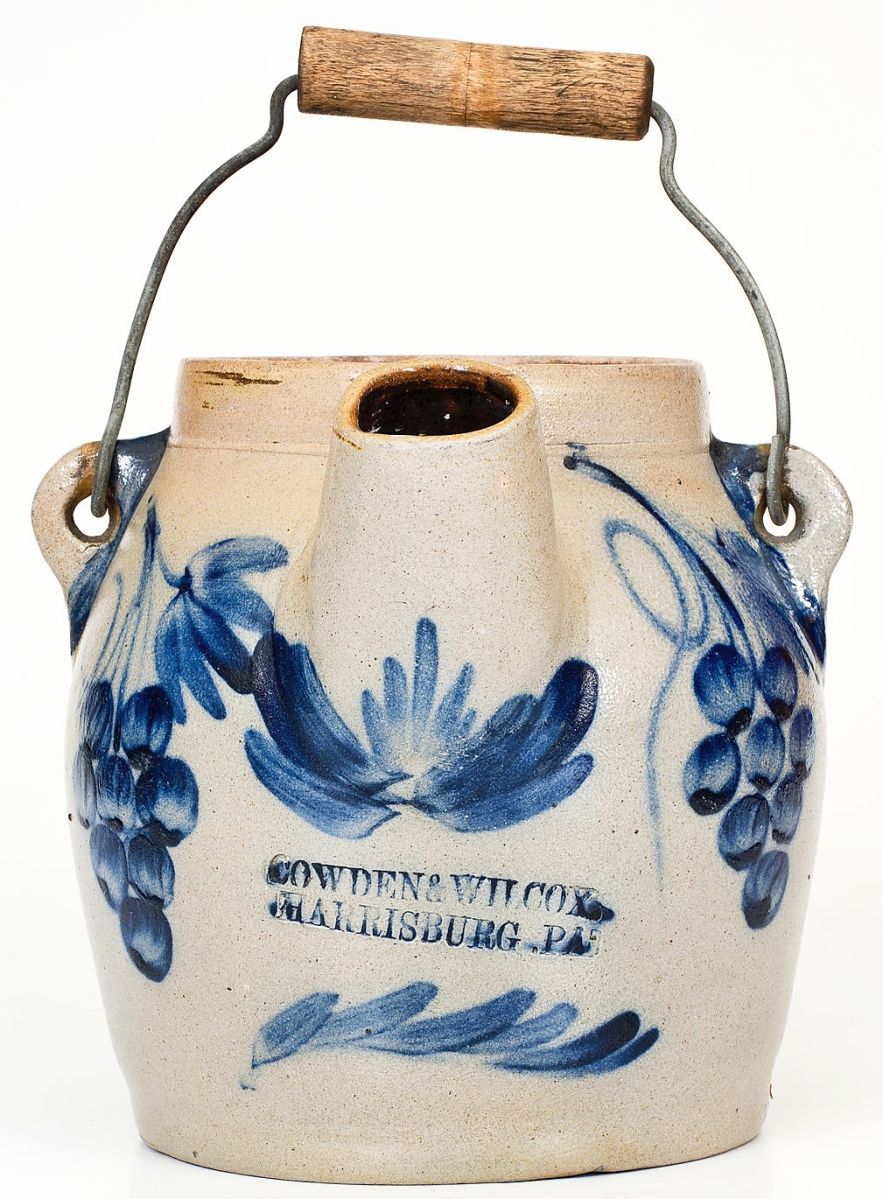
A Cowden & Wilcox batterpail with bird and grape decoration sold for $26,400. The one-gallon example combined two of the potter’s motifs not often seen together.
Pottery is increasingly offering museums new avenues to tell a more rounded, down-to-earth story of American history, one that looks past the academies to the lifestyles of the common man and woman. In the last five years, Zipp noted that Crocker Farm sold more pottery to museums than they had in the prior 12 years.
Another museum acquisition came in the form of the Anna Pottery Liberty Monument, which sold to Winterthur for $600,000.
“It was a discovery, it came from a dealer in the Western United States,” Zipp said. “They contacted us thinking it was sewer tile. I think it was probably a unique work.”
The result is an auction record for Anna Pottery and the Kirkpatrick brothers, who were no strangers to political messaging. It demonstrates the height of their expressiveness in the form of a towering monument with applied figural decoration. The work, circa 1873, measures 23 inches tall and is covered with an Albany slip glaze.
The scene is a play on the word “Colfax,” divided between a Civil Rights scene represented by the Colfax Massacre and another scene of political cronyism, hereby shown in the depiction of Schuyler Colfax, the vice president of the United States under Ulysses S Grant.
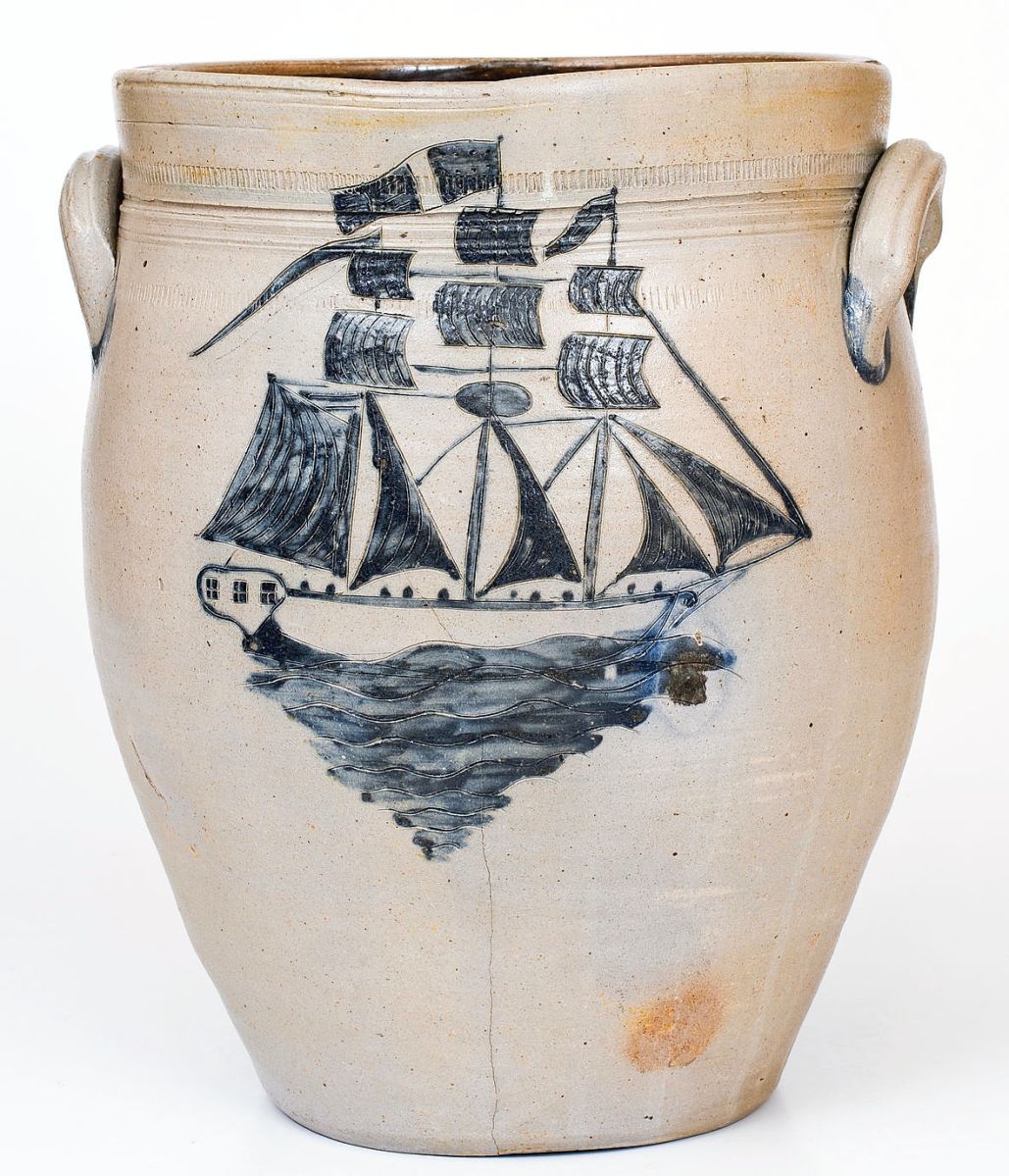
In the firm’s December sale, Crocker Farm got a six-figure result for a stoneware cooler with incised ship. The market offered up another in this 3-gallon jar of New Jersey origin that sold for $21,600. It measured 12¾ inches high.
On April 1, 1873, 153 Black militiamen were murdered at the Grant Parish Courthouse in Louisiana by a white supremacist mob, including ex-Confederate soldiers in what is now called the Colfax Massacre. The Black men had occupied the courthouse following a contested and allegedly fraudulent gubernatorial election.
Seen on the work are images of Black men protecting their children from armed Confederate men. A lion at the top represents Ulysses S. Grant, who together with the depiction of Lady Liberty, represents hope and leadership for a broken country.
On the other side of the work is Schuyler Colfax, who stands amid his well-dressed family in shame with his hand against his head. He was implicated in a wide-ranging fraud that saw high-ranking congressmen take bribes in return for issuing construction contracts to Credit Mobelier for work on the Transcontinental Railroad.
Zipp said, “The Kirkpatricks were very verbose, they like to write flowery things, funny things, tongue-in-cheek things, but they’re also doing this double meaning on the word ‘Colfax.’ The Colfax that have and the Colfax that have not – the one that had it and blew it and the others who never did.”
Alexandra Deutsch, the John L. and Marjorie P. McGraw Director of Collections at Winterthur, said, “From the moment we saw the Monument, we knew that, as an institution, we had a rare opportunity to add an object to the collection that would materially document a long-underrepresented American tragedy, the Colfax Massacre. We also knew that the Monument would allow us to engage with the past in a way that is intensely relevant to the present. This object will inspire challenging conversations. That is why it is such a powerful and important acquisition. We want to fully understand and make known the painful and complex history represented by the Kirkpatrick brothers in this singular work. We are engaging with community members, scholars, students and other stakeholders to bring multiple perspectives to the interpretation of this complex object.”
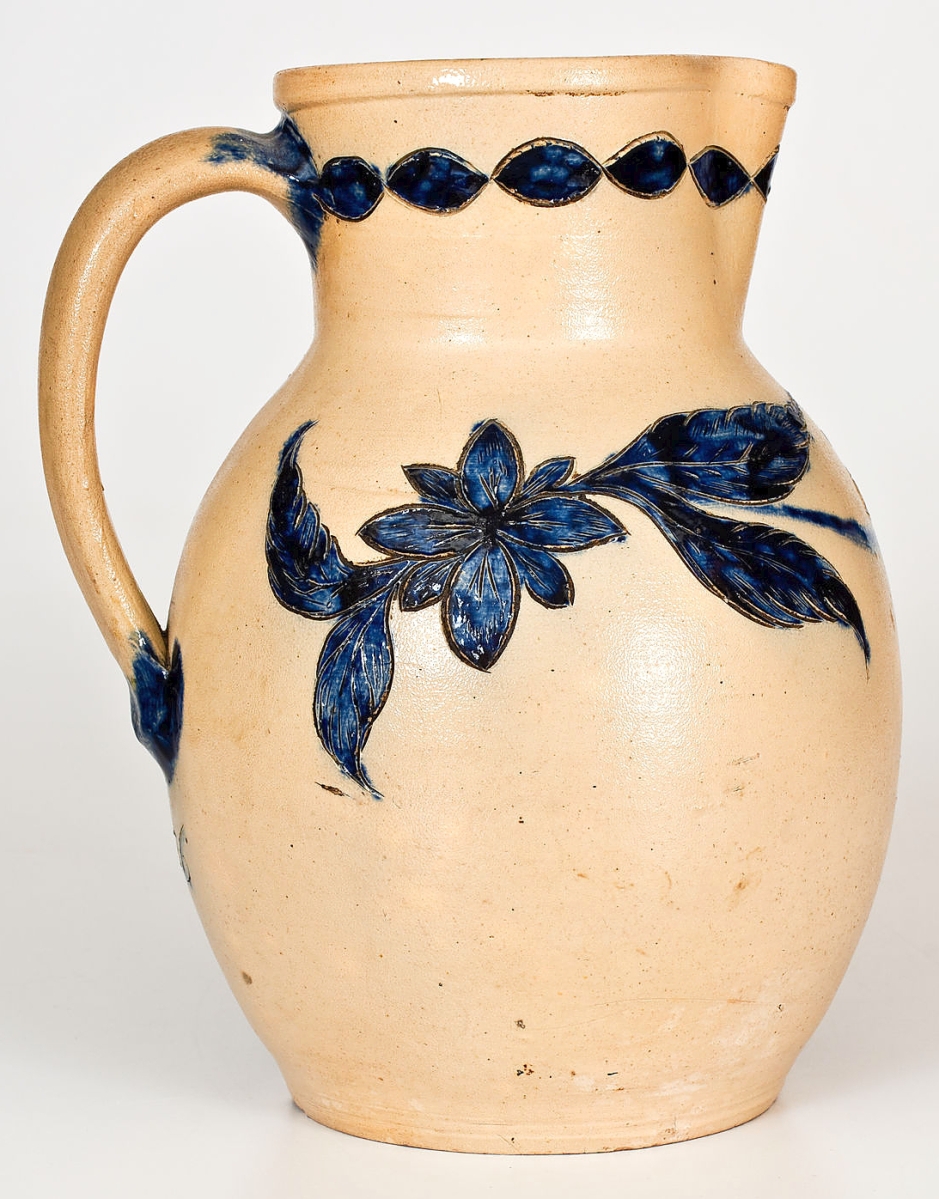
Crocker Farm attributed this salt-glazed stoneware pitcher to Henry Harrison Remmey as he worked in Philadelphia in 1856. The bold decoration lured bidders to $18,000.
Deutsch said that when the monument goes on exhibit in 2022, it will be the centerpiece of a gallery installation with related objects that the museum has been acquiring for more than 20 years.
“It’s a transformational acquisition,” she added.
While Dave Drake’s jar does not overtly mention Civil Rights and slavery, sincere scholarship has implicitly bound those themes to all of the potter’s works. It is an icon of the era it was made in, but it is also an icon of today and the era it sold in. That it appeared in the same sale with the Anna Pottery monument, which explicitly decried those tragedies, and that these two works now form the first and third highest auction results for American pottery, it’s enough of an indicator to see that we’re looking at a watershed moment for objects made by African Americans and that these objects hold an immeasurable amount of value in American history. Their existence is a testament to pain, but beneath the glaze is an unvarnished truth that will now be taught to the public in perpetuity.
Dave Drake, an enslaved African American, has risen to become the most valuable potter in American history.
All prices reported include buyer’s premium. For information, www.crockerfarm.com or 410-343-9691.

